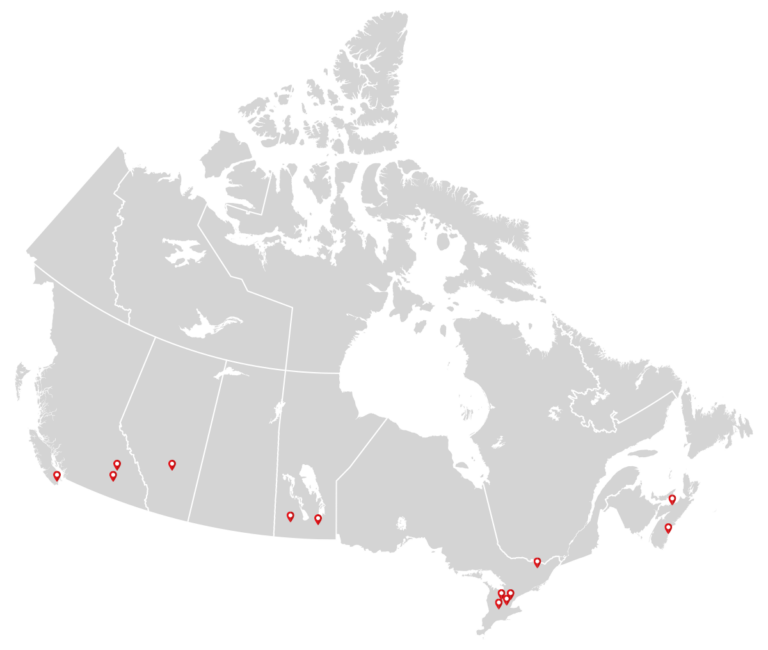CNAM Climate Cohort Knowledge Hub
The Canadian Network of Asset Managers Climate Action Cohort brought together 13 municipalities from across Canada. While there are many differences between participants, all share the common challenges of aging infrastructure in a changing climate.
This group of people spent a year getting to know each other through a series of virtual workshops and check ins designed to make gains in understanding the climate changes specific to their geography and how those changes are anticipated to impact their services and infrastructure. They also worked on considering climate in the definition and measurement of levels of service and incorporating climate change in evaluating risks. By the end of the year, participants brought everything together to project climate impacts to long-term capital finance.
This webpage captures a selection of their stories and shares some resources and tools that will help other communities in their journeys to integrate climate change and asset management.
Participants and Acknowledgements
Thank you to all the communities from across Canada who participated in the program:

We are very excited to share four case studies from the cohort, click the links below to hear their stories and learn what you can apply from the cohort within your community!

Background
Nestled in the picturesque British Columbian Shuswap with a growing population of approximately 19,400 the City of Salmon Arm (the City) has been steadily building and improving their asset management program for years.
“We call it Service Delivery Management, to keep the focus on the services and so all staff can see their role in it” says Jenn Wilson, Service Delivery Management Coordinator for the City. The City’s journey of formalizing asset management practices began more than a decade ago when Jenn (as the City Engineer at the time) attended NAMS training together with the City’s CFO. Their goal was to support a shift from reactive to proactive decision-making. Following the training, staff worked to incrementally build systems for service delivery management – yet it often felt like the work was being done off the sides of their desks.
In 2021, City Council approved a Service Delivery Management policy along with funding for a full-time position of Service Delivery Management Coordinator. The top-down endorsement gave new momentum to the foundational work that had been done by staff in prior years.

Background
The Rural Municipality of Dufferin is a small rural community located southwest of Winnipeg. The RM has roughly 2,500 residents and covers an area of about 916 square kilometres. The RM of Dufferin is home to farmers, agri-business, and the University of Manitoba Ian N. Morrison Research Farm.
The RM of Dufferin may not be a big municipality or have a lot of resources to spare but they are taking steps in integrating climate action and asset management.
 Background
Background
The City of Burlington, situated in the Regional Municipality of Halton on the western shore of Lake Ontario, is home to a population of 186,948 as of 2021. Prior to its involvement in the Climate Action Cohort, the City laid a strong foundational work in climate action and asset management. This groundwork included the declaration of a Climate Emergency (2019), and the development of an Asset Management Plan (2021), a community Climate Action Plan (2020), a Corporate Energy and Emissions Management Plan (2019), a Climate Projections for Burlington report (2021), Climate Change Impacts story map, and the Climate Resilient Burlington (CRB) Plan (2022).
A climate emergency was declared for the purposes of deepening the City’s commitment to protecting its economy, environment, and community from climate change; and that Council and staff immediately apply a climate lens to its plans and actions including the Council strategic workplan and future budgets.
The CRB Plan aims to support adapting to warmer, wetter, and wilder weather by identifying actions to manage the increasing risks due to climate change. A key action item that was identified in the Plan was to integrate the climate impacts in Burlington’s Asset Management Plan and to build an internal team to champion work towards that goal.

Background
The City of Brandon, located in the southwestern corner of Manitoba, is a growing mid-sized City. Located in Treaty 2 Territory. It is the ancestral land of the Anishinaabe, Anishininewuk, Dakota Oyate, Denesuline, Ininiwak, and Nehethowuk peoples. The City has an approximate population of 54,000.
“CNAM has been delighted with the success of this program, and we're excited to share details of these case studies and other resources that can help you and your community move forward. We are keen to continue to work with FCM and other partners to support asset management practitioners, particularly with regards to integrating climate issues. with asset management practices.”
Bernadette O’Connor CNAM Chair 2022-2023
CNAM’s Climate Cohort was led by Urban Systems.
CNAM’s Municipal Asset Management Program was managed by icInfrastructure.

This initiative is offered through the Municipal Asset Management Program (MAMP), which is delivered by the Federation of Canadian Municipalities (FCM), and funded by the Government of Canada.

Keep in touch with CNAM!
Join CNAM’s Newsletter and Mailing List
Learn about CNAM Membership
Canadian Network Of Asset Managers
1 Eglinton Avenue East, Suite 705
Toronto, ON M4P 3A1
Phone: 416.335.0171
Fax: 416.981.8759
Email: membership@cnam.ca
© 2021 Canadian Network of Asset Managers. All Rights Reserved. | Legal & Copyright
